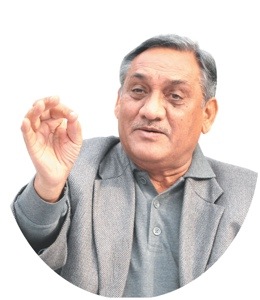Dehradun : Either he was too naïve about it, or it was a faux passé, but Uttarakhand chief minister Vijay Bahuguna had his facts wrong when he tried to attribute less water in the reservoirs of the state, for the low power generation, resulting in the power shortage that the state has been facing for almost an year now.
Talking to newspersons here, he said that because of the summer months the water levels in the rivers fall resulting in there being less water in the reservoirs and hence fall in power generation. But on the contrary, it is quite the opposite, because of the increase in melting of snow during the summer months, water discharge in the rivers increase resulting in an increase in generation during the summer months.
On the other hand it is actually in the winters, as the water starts freezing in the higher reaches due to the low temperatures that the water discharges in the rivers reduce, which in turn reduces the power being generated in the hydel power projects.
He was also off the mark, when he said that power consumption increases in the summers and goes down in the winters, which is true for the states in the plains. In the mountain states, like Himachal Pradesh and Uttarakhand, power consumption increases in the winters as people switch on heaters to warm the rooms and themselves.
It is because of this that Himachal Pradesh has a banking agreement with Punjab, Delhi and some other states of the plains. Himachal has excess power during the summers because of increased generation and lower consumption, which it gives to the states of Punjab, Delhi, Haryana and Rajasthan, where power consumption increases due to use of air conditioners, fans and for running tubewells for irrigation purposes, on a banking agreement.
During the winters, when consumption in the state increases as most of the houses resort to using heaters to warms themselves and room, and generation in the power projects falls down due to less water discharge of the rivers, the gap between supply and demand widens. To meet its power needs during these months, it takes back the power that it has given to the other states during the summer to meet its shortfall and ensure there are no power cuts.
The power generation peaks during the monsoons when the rivers are in spate, but when the silt levels in the rivers go up due to torrential rains or severe landslides and landslips and there are fears that the turbines could be damaged, water is diverted and generation is stopped. But this happens for a a day or two, and as the silt levels come down generation again starts. Most of the hydel projects generate the maximum power during the monsoon months.
A journalist with over 40 years of experience, Jagdish Bhatt was Editor, Hill Post (Uttarakhand).
Jagdish had worked with India’s leading English dailies, which include Times of India, Indian Express, Pioneer and several other reputed publications. A highly acclaimed journalist, he was a recipient of many awards
Jagdish Bhatt, aged 72, breathed his last on 28th August 2021 at his Dehradun residence.




This happens if you choose uneducated leaders from families.. Or Reservation of families over merit….